Assisted Living and Health Care: What are the Differences?
When considering senior living options, it is essential to understand the differences between assisted living and health care and the ideal time to explore senior living and move to a continuing care retirement community (i.e. life-plan community).
Assisted Living and Health Care Differences
Definitions
Assisted living is designed for older adults who require some assistance with daily living activities but are still able to maintain some level of independence. Additionally, some communities offer memory care support (e.g. Alzheimer’s disease, dementia). Lutheran Village at Miller’s Grant will be expanding its assisted living to include a memory support neighborhood.
Alternatively, health care is intended for older adults who require short-term rehabilitation or more intensive care due to chronic illness, disability or terminal disease. Like the services found in typical nursing homes, older adults can be admitted for short-term rehabilitation after hospitalization or as a permanent resident who needs long-term care that requires 24-hour care and supervision.
Services and Costs
In assisted living, residents receive assistance with daily living activities such as bathing, dressing and medication management. In addition, they have access to various amenities such as transportation, housekeeping and laundry services, as well as social events and activities. According to Genworth’s 2021 Cost of Care Survey, the average cost of assisted living in Maryland is $161 per day but the cost can vary depending on the level of care needed. Payment options include private pay and long-term care insurance.
Health care services may include on-site medical specialists, rehabilitation (i.e. physical, occupational and speech therapy) and medication management. According to the same Genworth study, the average cost in Maryland for a private room is $400 per day and less for a shared/semi-private room at $340 per day. These costs can also vary based on the level of care required. Payment options for health care include Medicare Part A and long-term care insurance.
Living Arrangements
Assisted living typically offers private living suites, as in the case of LVMG; however, shared living may also be offered at some communities.
Health care facilities typically offer both private and shared/semi-private rooms. LVMG offers both options with shared/semi-private rooms separated by a wall with residents only sharing a bathroom.
Best Time to Move
Older adults should plan early for their retirement years including learning about available senior living options. According to U.S. News and World Report’s The Best Age to Move into a CCRC, it’s best that older adults accept earlier rather than later that they may need help at some point.
If a CCRC, like LVMG is in their future, they can move into independent living while they are still young and independent enough to take advantage of all the services and amenities that help them remain active for as long as they are able. If their care needs increase, they can seamlessly transition to assisted living or health care.
CCRCs offer three care levels – independent living, assisted living and health care. Assisted living is ideal when some assistance is needed and is typically less costly than health care where more intensive care is provided. All three care levels depend on the individual’s care needs.
With the numerous activities and events that help older adults remain active for as long as they are able, it’s recommended they move to a CCRC early in their retirement, so they can enjoy the resort-like lifestyle CCRCs offer sooner and avoid the stress of having to find a community when an emergent need arises.
Learn more about senior living options, including independent living, from our Senior Living Options Guide, and explore CCRCs’ services and amenities.
Our sales and marketing team can also help answer questions and provide tours of our community.





